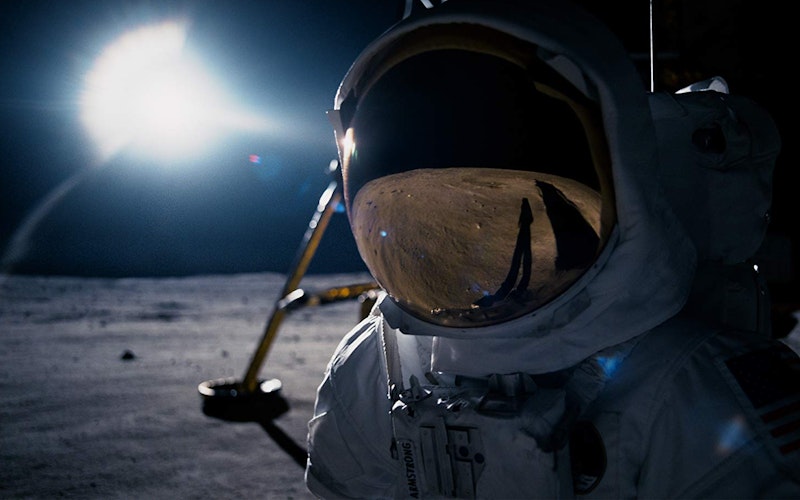
Movies
It is Not Good for (First) Man to be Alone
Neil Armstrong spends much of First Man in solitude, and he likes it that way.
Even when he’s accompanied by a fellow astronaut in one of the movie’s many flight scenes, Armstrong (Ryan Gosling) seems to regard his colleague as a necessary nuisance. Practical and precise, he’d rather be alone, following protocols, working the problems that arise, and completing the flight without much fuss. Many of the cockpits we see in First Man are claustrophobic, with barely enough room for one. You get the feeling that suits Armstrong just fine.
Some of this is a matter of personality. Gosling has a talent for stoicism, so he was a good choice for the part (he’s also gifted enough to hint at the drive and determination whirring away inside Armstrong’s head). Yet the movie, adapted by director Damien Chazelle from James R. Hansen’s biography, also presents Armstrong’s detachment as a response to the death of his young daughter, which is excruciatingly recounted in the film’s early scenes. Becoming laser-focused on his work at NASA is a way for Armstrong to push his grief aside. And while it may be exactly this sort of obsession that makes him successful (the movie’s ambivalence about such professional perfection is also a key theme in Chazelle’s jazz drama, Whiplash), it comes at great cost. In devoting himself so wholly to space exploration, Armstrong emotionally abandons his wife Janet (Claire Foy) and their two sons.
Neil and Janet, then, are no Adam and Eve. The actual first man was created to be in relationship, for as God declares in Genesis 2:18, it is “not good for the man to be alone.” From this we can presume that solitude is not our intended state as created beings. John Calvin, in his commentary on the passage, says that “man was formed to be a social animal,” something that can be difficult for those of us who are introverts to accept.
Genesis 2:18 is often regarded as a foundational text regarding marriage, and indeed marriage is one place where creational relationship can be beautifully expressed. A nice touch in First Man is that Foy’s Janet gets more domestic scenes than the wives usually do in these sorts of historical space dramas. In fact, one parallel sequence cuts back and forth between her at home and Armstrong in flight, suggesting that playing referee between two rambunctious boys might be just as challenging as keeping a spacecraft in orbit. The implication is that she is both Armstrong’s partner on the home front and his equal in life.
Solitude is not our intended state as created beings.
God’s vision of relationship is not limited to marriage, however. Genesis 2:18 applies equally to, say, children, or single adults, or people whose partners have died. A devotional at Ligonier Ministries offers this observation about Genesis 2:18: “Though made in the image of God, a personal and triune being, the first man cannot yet bear the image of God fully because he has no peer with whom he can relate (like the Father, Son, and Holy Spirit do).” One way we reveal the image of God, which is three in one, is by sharing our lives with peers, being in relationship, building community.
In First Man, even Armstrong has this latent yearning for community. Consider the movie’s riveting opening scene, in which he punctures the earth’s atmosphere during a test flight. There’s a moment of blissful peace as he floats on the edge of outer space, enjoying the accomplishment. But then the scene shifts to panic as he tries to return to earth but, instead, repeatedly bounces off the atmosphere. Yes, his life is at risk, but there’s also something existentially terrifying at play—the awareness that the isolation he mostly prefers could become horrifyingly final if he were unable to return home.
During a later test flight that also goes awry, Chazelle repeatedly cuts to an image that speaks to this theme of human connection. In between pressing buttons and flipping switches in an attempt to stabilize his spinning craft, Armstrong desperately places his hand against the tiny window, a futile attempt to reach out to earth. Later, during the movie’s climax on the moon, Armstrong makes another significant gesture that speaks to relationship (I won’t spoil it here). He’ll never be more alone than he is in this place—filmed with Imax cameras, the sequence stunningly captures the vastness of the lunar landscape—yet Armstrong’s action suggests that such solitude is, ultimately, empty.
First Man ends on a lovely final image, yet another gesture involving an outstretched hand. Notice, though, that a barrier still exists between the two people involved (I’m not going to spoil these details either). In this fallen world, loving others often comes with a cost: a friendship that fades, a relationship that fails, a child who is lost. In his fullness, God fulfills the emptiness that human relationships, even at their best, only partly address. God not only embodies true community and relationship in the Trinity, but literally offers it in the person of Jesus. That’s good news, for introverts and extroverts alike.
Topics: Movies